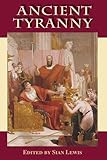Ancient Tyranny / Sian Lewis.
Material type: TextPublisher: Edinburgh : Edinburgh University Press, [2022]Copyright date: ©2006Description: 1 online resource (282 p.)Content type:
TextPublisher: Edinburgh : Edinburgh University Press, [2022]Copyright date: ©2006Description: 1 online resource (282 p.)Content type: - 9780748621255
- 9780748626434
- online - DeGruyter
| Item type | Current library | Call number | URL | Status | Notes | Barcode | |
|---|---|---|---|---|---|---|---|
 eBook
eBook
|
Biblioteca "Angelicum" Pont. Univ. S.Tommaso d'Aquino Nuvola online | online - DeGruyter (Browse shelf(Opens below)) | Online access | Not for loan (Accesso limitato) | Accesso per gli utenti autorizzati / Access for authorized users | (dgr)9780748626434 |
Frontmatter -- Contents -- Acknowledgements -- Contributors -- Abbreviations -- Figures and Tables -- 1. Introduction -- Part I The making of tyranny -- 2. Kingship and tyranny in archaic Rome -- 3. Ducetius and fifth-century Sicilian tyranny -- 4. Adfectatio regni in the Roman Republic -- 5. Money and the Great Man in the fourth century BC: military power, aristocratic connections and mercenary service -- 6. From Agathocles to Hieron II: the birth and development of basileia in Hellenistic Sicily -- Part II Tyranny and politics -- 7. Tyrants and the polis: migration, identity and urban development in Sicily -- 8. Synchronicity: the local and the panhellenic within Sicilian tyranny -- 9. Alexander of Pherae: infelix tyrant -- Part III The ideology of tyranny -- 10. Pindar and kingship theory -- 11. The comic Pericles -- 12. Tyrannical oligarchs at Athens -- 13. Plutarch and the Sicilian tyrants -- 14. Reckoning with tyranny: Greek thoughts on Caesar in Cicero’s Letters to Atticus in early 49 -- Part IV The limits of tyranny -- 15. The violence of the Thirty Tyrants -- 16. The politics of Persian autocracy, 424–334 BC -- 17. Sulla the weak tyrant -- Bibliography -- Index
restricted access online access with authorization star
http://purl.org/coar/access_right/c_16ec
GBS_insertPreviewButtonPopup('ISBN:9780748621255);Tyrants and tyranny are more than the antithesis of democracy and the mark of political failure: they are a dynamic response to social and political pressures.This book examines the autocratic rulers and dynasties of classical Greece and Rome and the changing concepts of tyranny in political thought and culture. It brings together historians, political theorists and philosophers, all offering new perspectives on the autocratic governments of the ancient world.The volume is divided into four parts. Part I looks at the ways in which the term 'tyranny' was used and understood, and the kinds of individual who were called tyrants. Part II focuses on the genesis of tyranny and the social and political circumstances in which tyrants arose. The chapters in Part III examine the presentation of tyrants by themselves and in literature and history. Part IV discusses the achievements of episodic tyranny within the non-autocratic regimes of Sparta and Rome and of autocratic regimes in Persia and the western Mediterranean world.Written by a wide range of leading experts in their field, Ancient Tyranny offers a new and comparative study of tyranny within Greek, Roman and Persian society."
Mode of access: Internet via World Wide Web.
In English.
Description based on online resource; title from PDF title page (publisher's Web site, viewed 29. Jun 2022)


